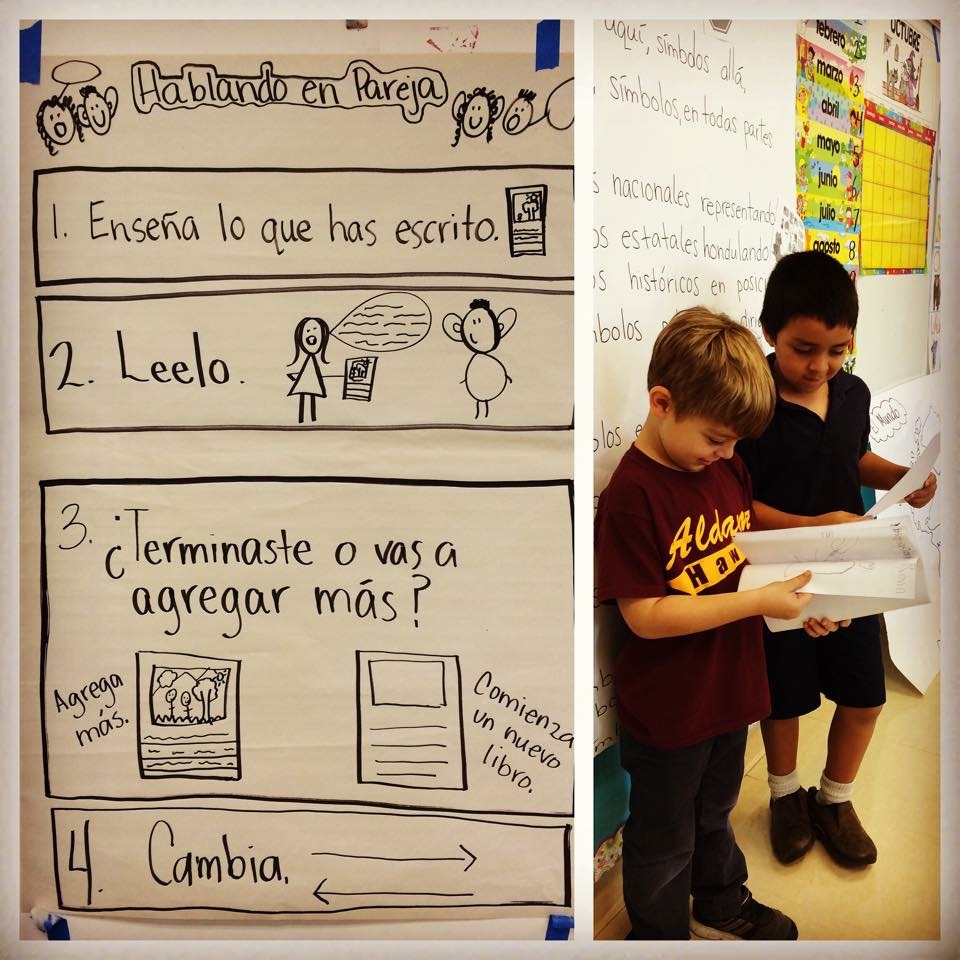People tend to shy away or reject what intimidates them. Change is hard.
I’ve found that to be the case when it comes to the Common Core State Standards. It looks like we’re asking kids to climb unscalable heights, but really, they’re hills.
The biggest hurdle in my experience as a teacher is getting over the belief that kids shouldn’t have more expected of them, including our youngest students.
To provide teachers with the necessary professional development that makes the Common Core State Standards comprehensible and instructionally accessible to teachers and children is a challenge.
For example, Common Core requires children in kindergarten to write narrative, opinion and informational pieces. Some might look at these standards and think it’s absurd to set such lofty goals for children who are not far removed from sounding out their first words. But I know that it’s possible because I teach my students to write in two languages everyday.
It’s Hard When You Don’t Speak the Language
I teach kindergarten at Aldama Elementary School, a public school in the Los Angeles Unified School District (LAUSD), where Latino youths represent about 90 percent of the student body. I have been using the Common Core State Standards to successfully teach reading and writing to my students. We have been implementing them in our dual language immersion program, the first of its kind in LAUSD.
I piloted the dual language immersion program in Spanish and English in 2008 and it is now one of the most highly sought-after programs in LAUSD—people camp out overnight in order to register their children.
One issue in my district is that many teachers haven’t received the professional development that they need to feel prepared to implement the standards. Professional development has to be a priority for district leadership because not all teachers have access to the latest research and most effective technology to help them.
The Common Core State Standards are ambitious and to those not well-versed on them, they seem impossible to bring about in the classroom.
But It’s Not Always Sink or Swim
Our success happens step by step. We don’t simply throw children into the water. Students learn how to pre-write with reading and thinking. A lot of the time, reading is guided. I discuss what I read to the children to check for understanding. Multiple drafts of drawings, dictations and writing occur throughout the school year.
My job is to guide my kindergartners through the process, helping them to gather and articulate information, showing them how to organize their thoughts and how to create a draft with proper nouns and verbs to compose coherent sentences.
The emphasis is not on complicated grammar or to create elaborate arguments or stories, but to answer basic questions—who, what, where, when and why.
Kindergartners are capable of meeting the Common Core standards if they have active coaching and guidance. Common Core isn’t abstract or daunting; it helps connect classroom lessons to their lives.
Using course material from the Reading and Writing Project out of Teachers College at Columbia University, I successfully cover the Common Core State Standards in writing.
I ask five-year-old students to reflect on their lives for personal narratives, to select topics that they are passionate about for informational writing and by asking them what they’d like to change about the world for opinion writing.
They Can’t Write in Sentences, But They Can Think Them
Developmentally, kindergarten children cannot write sentences yet, but they can think in sentences, and I can dialogue with them and take their dictation, and they can begin to compose text, with my support, at their own pace.
I like to ask my students, “What do you love? What are you crazy about?” These questions become the topic for their assignment.
One student wrote a wonderful piece on the Staples Center sports arena in downtown Los Angeles. He included details about what it looked like inside and diagrammed the building’s interior. He labeled everything—where the announcers sit and the placement of the scoreboard. He put together a 15-page booklet explaining everything he knew about the arena.
Encourage kids to talk about what they love and you’ll get the best out of them. If we equip teachers with the resources to meet the Common Core standards, teachers and students will rise to the occasion and achieve excellence.
Common Core gives me the freedom to teach the way I want and for my kids to explore what interests them. Common Core hasn’t thwarted creativity, mine or theirs, one bit.
Angelina Sáenz
Sáenz received the 2014 La Opinion Exceptional Woman Award for her work in education and was a finalist for the Commitment to Excellence Award as a Champion of Change with President Obama’s Advisory Commission on Educational Excellence for Hispanics.
She graduated from Occidental College in 1998, with a bachelor’s in theater and anthropology and and received her master’s in education in 2001 from Claremont Graduate University.
Latest posts by Angelina Sáenz (see all)
- Why Should Finland Matter to You: Excellence in Public Schools is Possible - January 4, 2016
- Dual Language Immersion: Teaching Our Children Spanish and English is Just the Beginning - December 28, 2015
- Kindergarten! Yes We Can! Supporting your child in their transition - December 16, 2015
- Teaching Kindergartners to Think in Sentences - October 9, 2015

